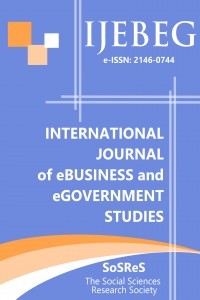SPREADING WEBSITE USABILITY AND ACCESSIBILITY INTO SOCIETY: EXAMPLES FROM PUBLIC AND PRIVATE SECTORS IN TURKEY
SPREADING WEBSITE USABILITY AND ACCESSIBILITY INTO SOCIETY: EXAMPLES FROM PUBLIC AND PRIVATE SECTORS IN TURKEY
Usability, Accessibility,
___
- Alacam, O, DalcD, M. (2009) A replication usability study of WEB mapping sites with eye tracker: The effects of iconic representation of information . HCII2009 San Diego
- Albion, P. (1999). Heuristic evaluation of educational multimedia: From theory to practice.
- Proceedings of the 16th Annual Conference of the Australasian Society for Computers in Learning in Tertiary Education (pp. 9-15). Brisbane: Australasian Society for Computers in Learning in Tertiary Education. BalcD, A., KumaT, E., TaTdelen, H., Süngü, E., Medeni, T., Medeni, T. (2008) Development and Implementation of e-Government Services in Turkey: Issues of Standardization, Inclusion,
- Citizen and Satisfaction. ICEGOV2008 Egypt
- Bevan, N. (1997) Quality and usability: A new framework. van Veenendaal, E, and McMullan,
- J (eds) Achieving software product quality, Tutein Nolthenius, Netherlands, Fu, L., Salvendy, G., and Turley, L. (2002) Effectiveness of user testing and heuristic evaluation as a function of performance classification, Behaviour & Information Technology, (2), pp. 137- 143.
- Jacob, R. J. K., & Karn, K. S. (2003). Eye tracking in human-computer interaction and usability research: Ready to deliver the promises (Section commentary). In J. Hyona, R.
- Radach, & H. Deubel (Eds.), The Mind's Eyes: Cognitive and Applied Aspects of Eye Movements. Oxford: Elsevier Science. JRC EC (2009). The impact of social computing on the EU information society and economy
- Krug, S. (2000). Don’t Make Me Think : A Common Sense Approach to Web Usability
- New Riders 2nd Edition Nielsen, J. (2000). Why You Only Need to Test With 5 Users. [On-line]. Available: http://www.useit.com/alertbox/20000319.html
- Nielsen, J.(1994). How to Conduct a Heuristic Evaluation. Retrieved January, 2010, from http://www.useit.com/papers/heuristic/heuristic_evaluation.html.
- Nielsen, J. (1994 ) Usability Engineering Morgan Kaufmann, San Francisco,.
- Peng, L. K., Ramaiah, C. K. and Foo, S. (2004). Heuristic-based User Interface Evaluation at
- Nanyang Technological University in Singapore, Program: Electronic Library and Information Systems 38 (1): 42-59. Nat Nur (2009) e-Devlet KapDsDnda Engelli bir VatandaT, (A disabled citizen at EGG) YEBKO
- Başlangıç: 2009
- Yayıncı: Sosyal Bilimler Araştırmaları Derneği
FUZZY APPROACH IN IMPLEMENTATION OF E-GOVERNMENT IN THE FIELD OF REGIONAL DEVELOPMENT REGULATION
POLICY COHERENCE, EFFECTIVENESS, OPENNESS AND PARTICIPATION IN EUROPEAN UNION
Asim BALCI, Mustafa DALCI, Ersin KARAMAN, Ugurcan KUTLUOGLU, Cihan Yildirim YUCEL, Tunc MEDENI
